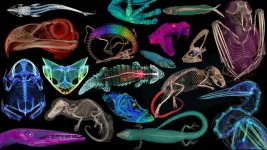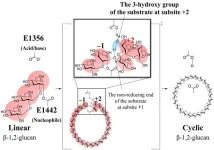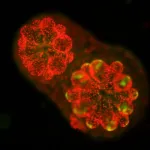(Press-News.org) Spinal muscular atrophy, or SMA, is the leading genetic cause of infant death. Less than a decade ago, Cold Spring Harbor Laboratory (CSHL) Professor Adrian Krainer showed this brutal disease can be treated by tweaking a process called RNA splicing. This breakthrough resulted in Spinraza, the first effective treatment for SMA. It also opened a new frontier in drug development. Now, CSHL research could push RNA-splicing drugs even further. CSHL Associate Professor Justin Kinney, Krainer, and postdoc Yuma Ishigami have figured out why some splicing-based drugs tend to work better than others.
RNA splicing determines which gene segments are used to build a protein. Krainer had designed Spinraza to home in on the exact spot where the drug would modify the production of a specific protein SMA patients need. Not all splice-modifying drugs are so intentionally constructed. Some have been found to change RNA splicing without scientists fully understanding how. That’s true for a recently approved SMA drug, risdiplam.
To better understand how this drug works, the Kinney and Krainer labs analyzed risdiplam’s interactions with RNA. They also examined RNA’s interaction with another drug, branaplam. The researchers measured the drugs’ effects on splicing throughout the genome and on hundreds of variations of their intended targets. From there, they modeled how each drug identifies its targets among all RNA inside a cell.
Both risdiplam and branaplam alter RNA splicing to generate the protein needed to treat SMA. However, the researchers found that risdiplam is more specific. Their quantitative models explain how. In the simplest terms, branaplam binds to RNA in two different ways—whereas risdiplam only binds in one way. This finding could help researchers alter the chemical structure of branaplam so that it might someday treat Huntington’s disease—a fatal, currently incurable neurodegenerative disorder.
The researchers also found something else. Combining splice-modifying drugs that target the same gene segment in different ways usually has a greater effect than either drug alone.
“You get synergistic interactions,” Kinney explains. “We found synergy is a general property of splice-modifying drugs. This might provide a basis for using drug cocktails instead of individual drugs.”
The finding could help researchers identify drug combinations with the potential to improve patient outcomes. And that could lead to new therapeutic strategies for SMA and other diseases. For example, the Krainer lab recently investigated RNA splicing in pancreatic cancer.
“Our new study provides insights into the action and specificity of splice-modifying drugs,” Krainer says. “This should facilitate the development of more effective drugs and drug combinations for a variety of diseases.”
END
Why some RNA drugs work better than others
2024-03-06
ELSE PRESS RELEASES FROM THIS DATE:
Scientists-CT scanned thousands of natural history specimens, which you can access for free
2024-03-06
Read the online version (Available 8:00 a.m. ET, March 6, 2024)
Watch the video (Embargoed. Do not distribute before 8:00 a.m. ET, March 6, 2024)
Natural history museums have entered a new stage of scientific discovery and accessibility with the completion of openVertebrate (oVert), a five-year collaborative project among 18 institutions to create 3D reconstructions of vertebrate specimens and make them freely available online.
Researchers published a summary of the project in the journal BioScience in which they review the specimens that have been scanned to date and offer a glimpse of how the data might be used to ask new questions ...
INFUSE workshop gives private and public fusion partners a chance to network and share experiences
2024-03-06
More than 120 people gathered for the 2024 Innovation Network for Fusion Energy (INFUSE) Workshop at the U.S. Department of Energy’s (DOE) Princeton Plasma Physics Laboratory (PPPL) from Feb. 27-28.
The event, which was sponsored by the DOE’s Office of Fusion Energy Sciences (FES), is a part of the INFUSE awards program that funds laboratories or universities so they can partner with private sector companies working on the science and technology ...
Uncovering the cyclization mechanism of cyclic β-1,2-glucan synthase
2024-03-06
The polysaccharide β-1,2-glucan consists of repeating units of glucose linked together by β-1,2-glycosidic bonds. Cyclic β-1,2-glucans (CβGs) occur in different bacterial species and have a role in bacterial infections and symbiotic relationships. CβG biosynthesis is catalyzed by cyclic β-1,2-glucan synthase (CGS), an enzyme that catalyzes the cyclization (closed ring formation) of linear β-1,2-glucan (LβG).
Since the method for large-scale enzymatic synthesis of linear β-1,2-glucan has already been established, combining it with this enzyme is technically feasible for efficient ...
Marine algae implants could boost crop yields
2024-03-06
Scientists have discovered the gene that enables marine algae to make a unique type of chlorophyll. They successfully implanted this gene in a land plant, paving the way for better crop yields on less land.
Finding the gene solves a long-standing mystery amongst scientists about the molecular pathways that allow the algae to manufacture this chlorophyll and survive.
“Marine algae produce half of all the oxygen we breathe, even more than plants on land. And they feed huge food webs, fish that get eaten by mammals and humans,” said UC Riverside ...
Model estimates who benefits most from frequent COVID-19 boosters
2024-03-06
Patients kept asking a question that Nathan Lo, MD, PhD, infectious disease specialist, had a hard time answering: How often should I get my booster shot for COVID-19?
“It’s a question that we have all asked. My patients have asked; friends and family members have asked,” Lo said. “We point to the national vaccine recommendations, although increasingly this question has become challenging to answer. I didn’t quite have the estimates on hand that I might hope to share with patients.”
To build that evidence, Lo and his team at Stanford ...
XPANCEO and Nobel laureate unveil the new properties discovery in graphene-like materials, transforming healthcare, AI and AR
2024-03-06
XPANCEO, a deep tech company developing the first smart contact lenses with XR vision, health monitoring, and content surfing features, in collaboration with the Nobel laureate Konstantin S. Novoselov (National University of Singapore, University of Manchester) and professor Luis Martin-Moreno (Instituto de Nanociencia y Materiales de Aragon), has announced in Nature Communications a groundbreaking discovery of new properties of rhenium diselenide and rhenium disulfide, enabling novel mode of light-matter interaction with huge potential for integrated photonics, healthcare, and AR. Rhenium disulfide ...
More than half of American Indian youth may have abnormal or high cholesterol
2024-03-06
More than 70% of American Indian young adults aged 20-39 and 50% of American Indian teens have cholesterol levels or elevated fat in the blood that put them at risk for cardiovascular disease, suggests a study supported by the National Institutes of Health. In some cases, these levels — specifically high low-density lipoprotein (LDL) cholesterol, often thought of as “bad cholesterol,” — were linked to plaque buildup and cardiovascular events, such as heart attack and stroke.
The findings, ...
How does wearing makeup affect skin during exercise?
2024-03-06
New research published in the Journal of Cosmetic Dermatology reveals the effects of wearing cosmetic foundation during aerobic exercise on the skin and its pores.
The study included 43 healthy college students (20 males and 23 females). Foundation cream was applied to participants on half of the face in two different areas (forehead and upper cheek). The other half of the face served as control.
Moisture increased after exercise in both the non-makeup and makeup zones; however, there was a greater increase in moisture in the makeup zones. This may be a result of makeup preventing ...
Can artificial intelligence–based systems spot hard-to-detect space debris?
2024-03-06
An increasing number of space objects, debris, and satellites in Low Earth Orbit poses a significant threat of collisions during space operations. The situation is currently monitored by radar and radio-telescopes that track space objects, but much of space debris is composed of very small metallic objects that are difficult to detect. In a study published in IET Radar, Sonar & Navigation, investigators demonstrate the benefits of using deep learning—a form of artificial intelligence—for small space object detection by ...
How does a diabetes drug lessen symptoms of depression?
2024-03-06
Research in animals has shown that the diabetes drug dulaglutide, which is a glucagon-like peptide-1 (GLP-1) receptor agonist may reduce symptoms of depression. A new study published in Brain and Behavior reveals the mechanisms that are likely involved.
By conducting a range of tests in mice treated with and without dulaglutide, investigators confirmed the effects of dulaglutide on depressive-like behaviors, and they identified 64 different metabolites and four major pathways in the brain associated with these effects.
Markers of depression and the antidepressant effects of dulaglutide were linked to lipid metabolism, amino acid metabolism, energy metabolism, ...




